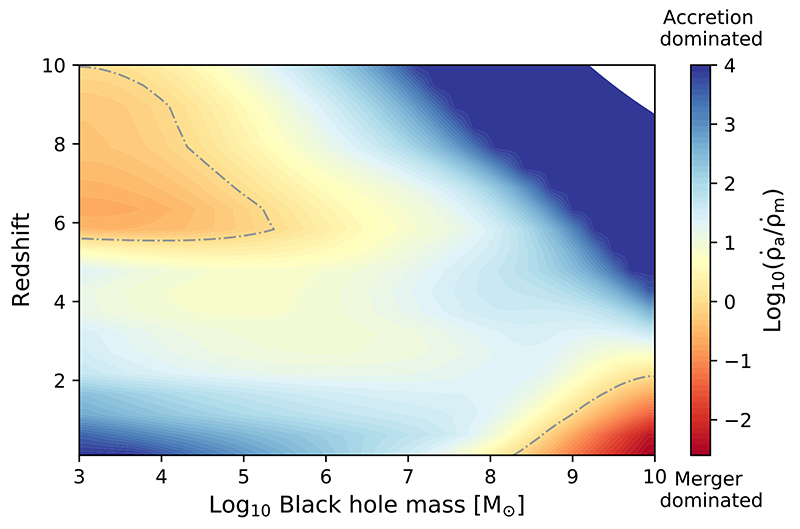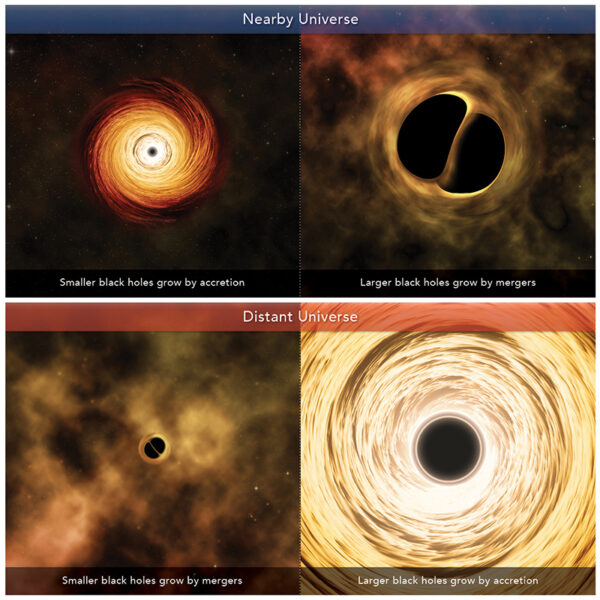Calculations suggest how black holes have amassed mass and predict what the black holes’ spins should be if this picture is correct.
Most of the growth black holes experience is due to guzzling gas and not by merging with other black holes, Fabio Pacucci (Harvard’s Black Hole Initiative) reported June 1st at the virtual American Astronomical Society summer meeting.
Black holes come in a panoply of sizes, with masses ranging from a few Suns to billions of them. The largest ones are tied to their host galaxies’ growth in a symbiosis that astronomers don’t yet understand. Nor do we know how the biggest behemoths came to be as massive as they are as early as they did.
To explore how black holes grow at different times in cosmic history, Pacucci and Abraham Loeb (also Harvard BHI) followed the objects’ evolution computationally. They started with a range of “seed” black holes, tens of solar masses and larger. Based on both observations and theoretical work, the astronomers made various assumptions about how fast the black holes would scarf down gas and how often they’d collide with their brethren. Then they followed the black holes over billions of simulated years.
The calculations, which also appear in the June 1st Astrophysical Journal, indicate that for black holes with masses between thousands and billions of Suns, accretion is the primary way the objects grow across all cosmic epochs. That’s especially true for the gargantuas in the universe’s first billion years or so, as well as black holes of thousands of solar masses today. (Astronomers are still working to find black holes of this smaller size.) This chart adapted from the team’s paper sums everything up:

adapted from F. Pacucci & A. Loeb / Astrophysical Journal2020
Or, if you prefer the short and sweet approach, try this:

M. Weiss
Previous calculations have suggested that black holes grown by gas accretion spin much faster — often at least 90% of their maximum — than those that beef up via mergers. Pacucci and Loeb thus predict that in today’s universe, smaller black holes should spin quickly, but leviathans of hundreds of millions of solar masses or greater will spin slower, more like half their maximum rate. When they tested this prediction by sorting 23 real spin measurements for black holes with a range of masses, they saw hints that their prediction is correct.
Black hole astrophysicist Laura Brenneman (Center for Astrophysics, Harvard & Smithsonian) says the team’s study is well thought out and compelling. But she cautions against concluding too quickly that the real universe matches the predictions. “Measuring black hole spin requires a lot of photons collected from very close to the event horizon,” she explains. With current instruments, that can require a day’s worth of exposure time to measure the rotation of a single bright, nearby object. “That’s a big reason why there are so few measured supermassive black hole spins in the literature right now: These are ‘expensive’ observations.”
What few spins astronomers do have come with notable uncertainties, and they’re likely biased toward high spins, work by Brenneman and others suggests. Ideally, astronomers would have hundreds of spin measurements before drawing conclusions about black holes’ pasts.
Pacucci acknowledges that the spin measurements aren’t precise, and he and Brenneman both also note that chaotic accretion — which the team didn’t take into account and might be particularly important early on — could change the effect on spin. But he’s encouraged by the fact that, when he and Loeb removed the less certain measurements and focused on the subset of better ones, they see the same trend.
How black holes grow also affects how we detect them. If black holes merge, then we’ll catch them with gravitational waves. If they surround themselves with blazing hot smorgasbords of gas, then we’ll find them with X-rays.
“It will be very interesting to see whether Pacucci and Loeb’s conclusions and predictions hold up in the 2030s as we launch the next generation of revolutionary X-ray and gravitational-wave observatories,” Brenneman concludes.
Reference: F. Pacucci and A. Loeb. “Separating Accretion and Mergers in the Cosmic Growth of Black Holes with X-ray and Gravitational Wave Observations.” Astrophysical Journal. June 1, 2020. Full text on the arXiv.
 2
2









Comments
Peter Wilson
June 11, 2020 at 7:31 pm
Why? Why is it that today, smaller BHs grow by accretion, whereas larger ones grow by merger; yet in the early universe, the opposite was true? What is the physical explanation for the reversal?
"Because that's what the computer simulations show!" Oh...
You must be logged in to post a comment.
Andrew James
June 12, 2020 at 8:36 pm
Black holes do exist beyond 'computer simulations'. Fact.
Statements made only to create doubt, solely based on some misunderstanding or agendas/beliefs, is not how science works. It is prevalent that our knowledge maybe incomplete but that does not imply or mean the phenomena(e) doesn't exist at all. Modelling enable us to test various theories or ideas to explain what we observe, therefore understanding and applying what we have earlier learnt. Each new learnt step is then independently further scrutinised and tested, either underpinning the earlier modelling, refining it, or going back a step or two and reassessing the premise of that modelling. However, discarding the whole thing altogether and starting again from scratch, especially when the observed phenomena has been ascertained by other independent methods, is not representative in how we conduct scientific research.
What is the physical explanation for the reversal? Simply,The disparity exists because black holes in the early universe rapidly formed from much larger stars in a higher density e.g. Population III stars, while more recent smaller black holes were created by ordinary stellar evolution processes. e.g. Supernovae Type II. Of course there a third premise e.g. Both accretion and mergers of black holes have occurred since the Big Bang, but happen a different rates as the Universe ages..
You must be logged in to post a comment.
You must be logged in to post a comment.